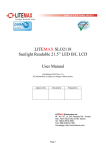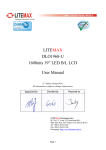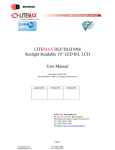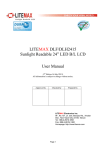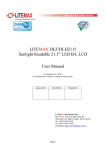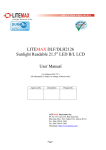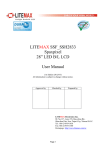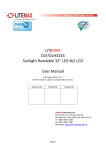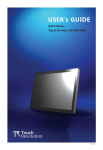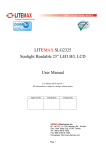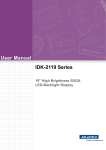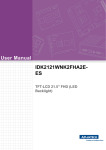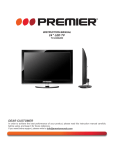Download LITEMAX SLD/SLO2115 Sunlight Readable 21.5” LED B/L LCD
Transcript
LITEMAX SLD/SLO2115 Sunlight Readable 21.5” LED B/L LCD User Manual (1st Edition 2010/12/15 ) All information is subject to change without notice. Approved by Checked by Prepared by Ming Hank Jacky LITEMAX Electronics Inc. 8F, No.137, Lane 235, Bau-chiau Rd., Shin-dian City, Taipei County, Taiwan R.O.C. Tel : 886-2-8919-1858 Fax: 886-2-8919-1300 Homepage: http://www.litemax.com.tw Page 1 RECORD OF REVISION Version Date Description V1.0 12/15/2010 Initial Release Page 2 Remark CONTENTS RECORD OF REVISION .................................................................................................. 2 1.0 GENERAL DESCRIPTION.......................................................................................... 4 1.1 OVERVIEW.......................................................................................................... 4 1.2 FEATURES .......................................................................................................... 4 1.3 APPLICATION...................................................................................................... 4 1.4 GENERAL SPECIFICATI0NS .............................................................................. 4 2.0 ELECTRICAL CHARACTERISTICS ........................................................................... 5 2.1 ELECTRICAL CHARACTERISTICS .................................................................... 6 2.2 LCD PANEL SIGNAL PROCESSING BOARD ..................................................... 7 2.3 Absolute Maximum Ratings.................................................................................. 8 2.4 SIGNAL TIMING SPECIFICATIONS .................................................................... 8 2.5 SIGNAL TIMING WAVEFORMS .......................................................................... 9 3.0 OPTICAL CHARACTERISTICS ................................................................................ 10 3.1 TEST CONDITIONS .......................................................................................... 10 3.2 OPTICAL SPECIFICATIONS ............................................................................. 10 4.0 MECHANICAL CHARACTERISTICS ........................................................................ 12 SLD1815 MECHANICAL SPECIFICATION.............................................................. 12 SLO1815 MECHANICAL SPECIFICATION ............................................................. 13 5.0 PRECAUTIONS ........................................................................................................ 14 5.1 HANDLING PRECAUTIONS.............................................................................. 14 5.2 STORAGE PRECAUTIONS............................................................................... 14 5.3 OPERATION PRECAUTIONS ........................................................................... 14 6.0 AD Board & OSD Functions ...................................................................................... 15 6.1 General Description ........................................................................................... 15 6.2 Outline Dimensions ............................................................................................ 16 6.3 AD2662 Board Pin Define .................................................................................. 19 6.4 I/O BOARD Pin Define ....................................................................................... 23 6.5 IR Receive Board Pin Define ............................................................................. 24 6.6 DC Characteristics. ............................................................................................ 24 6.7 OSD menu ......................................................................................................... 25 Page 3 1.0 GENERAL DESCRIPTION 1.1 OVERVIEW SLD/SLO2115 is 21.5” wide color a-Si TFT-LCD module as active switching devices with 1,000nits LED backlight powered by Durapixel™ technology. This module has a 21.5 inch diagonally measured active area with Full HD resolutions (1920* 1080). Each pixel is divided into RED, GREEN, BLUE dots which are arranged in vertical stripe and this module can display 16.7M colors. 1.2 FEATURES - 21.5” Sunlight Readable LED Backlight High Shock & Vibration Resistance Low Power Consumption High Uniformity Low EMI Noise Wide Dimming Life Expectancy (70,000hrs) 1.3 APPLICATION - Out/Indoor Display Marine, Military, Medical, Transportation Industrial 1.4 GENERAL SPECIFICATI0NS Model No. SLD/SLO2115 LCD Display Display Area (mm) Luminance Resolution Contrast Ratio Display Colors Pixel Arrangement Pixel Pitch (mm) Response Time Signal Connector F/R Control Button OSD Menu 21.5" LCD 476.64 (H) x 268.11 (V) 1000 cd/m2 1920 x 1080 1000 : 1 (Typ) 16.7M colors RGB (Red, Green, Blue) vertical stripe 0.24825mm 5ms (Typ.) 15 Pin D-sub, 29 Pin DVI Power Switch, Menu, Select (+,-) Brightness, Contrast, H/V Position, Color, Phase, Clock, Language, Management Power Consumption 20.5W Option Touch for customize (Resistive/ Capacitive) ※ Specifications subject to change without notice. Page 4 2.0 ELECTRICAL CHARACTERISTICS Page 5 2.1 ELECTRICAL CHARACTERISTICS Item Input Voltage Symbol Vin Input Current (Low Brightness) VIN=12V,Vadj=5V IinL Input Current (High Brightness) LED Current (Low Brightness) Conditions 10.0 12.0 15.0 V 0.0 ----- ----- 2.27 1.89 1.61 0.0 ----- ----- 1.028 1.028 1.028 517.75 545 180 200 220 HZ 0.5 ----- 4.8 V 2 ----- 5 20.64 20.63 20.6 V 93.47 93.51 93.95 % 70,000 ----- ----- Hrs VIN=12V,Vadj=0V IoutH Working Frequency Freq VIN=12V,Vadj=0V PWM Frequency Freq VIN=12V Brightness Control Vadj Efficiency Unit mA A VIN=12V,Vadj=5V IoutL (High Brightness) Output Voltage TYP. MAX. VIN=12V,Vadj=0V IinH LED Current ON/OFF Control MIN. Von/off Vout η Connection of Voltage Normal Operation VIN=12V,Vadj=0V VIN=12V,Vadj=0V Life time Page 6 Arms A 572.25 KHZ V 2.2 LCD PANEL SIGNAL PROCESSING BOARD The module using one LVDS receiver SN75LVDS82(Texas Instruments). LVDS is a differential signal technology for LCD interface and high speed data transfer device. LVDS transmitters shall be SN75LVDS83(negative edge sampling). The first LVDS port(RxOxxx) transmits odd pixels while the second LVDS port(RxExxx) transmits even pixels. Page 7 2.3 Absolute Maximum Ratings 2.4 SIGNAL TIMING SPECIFICATIONS Page 8 2.5 SIGNAL TIMING WAVEFORMS Page 9 3.0 OPTICAL CHARACTERISTICS 3.1 TEST CONDITIONS The LCD module should be stabilized at given temperature for 30 minutes to avoid abrupt temperature change during measuring (at surface 35℃). In order to stabilize the luminance, the measurement should be executed after lighting Backlight for 30 minutes in a stable, windless and dark room. 3.2 OPTICAL SPECIFICATIONS Item Contrast Ratio Luminance of White Min. - Typ. 1000 1000 Max. - Unit cd/m2 Note [1] [2] τDRV - 5 - ms [3] - 0.6336 0.3533 0.3326 0.6163 0.1447 0.0633 0.3182 0.3533 85 85 80 - - x axis, right(φ=0°) x axis, left(φ=180°) y axis, up(φ=90°) Rx Ry Gx Gy Bx By Wx Wy θr θl θu y axis, down (φ=0°) θd - 80 - Response Time Red Chromat icity Green Blue White Viewing Angle Symbol CRn LAVE Degree - Note: 1. Contrast ratio is measured by TOPCON SR-3 2. Surface luminance are determined after the unit has been ‘ON’and 1Hourafterlighting the backlight in a dark environmentat 25±2°C. Surface luminance is the luminance value at center 1-point across the LCD surface 50cm from the surface with all pixels displaying white. 3. Definition of Response time measured by Westar TRD-100A The output signals of photo detector are measured when the input signals are changed from “Full Black” to “Full White” (rising time, TrR), and from “Full White” to “Full Black” (falling time, TfF), respectively.The response time is interval between the 10% and 90% (1 frame at 60 Hz) of amplitudes. Page 10 Page 11 4.0 MECHANICAL CHARACTERISTICS SLD2115 MECHANICAL SPECIFICATION Item Horizontal(H) Vertical(V) Depth(D) Weight (Module only) Weight (1 module per box) Module Size Min. - Typ. 545 370 61 6.12 6.5 Page 12 Max. - Unit mm mm mm kg kg SLO2115 MECHANICAL SPECIFICATION Item Horizontal(H) Vertical(V) Depth(D) Weight (Module only) Weight (1 module per box) Module Size Min. - Typ. 545 370 60 5.5 6 Page 13 Max. - Unit mm mm mm kg kg 5.0 PRECAUTIONS 5.1 HANDLING PRECAUTIONS (1) The module should be assembled into the system firmly by using every mounting hole. Be careful not to twist or bend the module. (2) While assembling or installing modules, it can only be in the clean area. The dust and oil may cause electrical short or damage the polarizer. (3) Use fingerstalls or soft gloves in order to keep display clean during the incoming inspection and assembly process. (4) Do not press or scratch the surface harder than a HB pencil lead on the panel because the polarizer is very soft and easily scratched. (5) If the surface of the polarizer is dirty, please clean it by some absorbent cotton or soft cloth. Do not use Ketone type materials (ex. Acetone), Ethyl alcohol, Toluene, Ethyl acid or Methyl chloride. It might permanently damage the polarizer due to chemical reaction. (6) Wipe off water droplets or oil immediately. Staining and discoloration may occur if they left on panel for a long time. (7) If the liquid crystal material leaks from the panel, it should be kept away from the eyes or mouth. In case of contacting with hands, legs or clothes, it must be washed away thoroughly with soap. (8) Protect the module from static electricity, it may cause damage to the C-MOS Gate Array IC. (9) Do not disassemble the module. (10) Do not pull or fold the lamp wire. (11) Pins of I/F connector should not be touched directly with bare hands. 5.2 STORAGE PRECAUTIONS (1) High temperature or humidity may reduce the performance of module. Please store LCD module within the specified storage conditions. (2) It is dangerous that moisture come into or contacted the LCD module, because the moisture may damage LCD module when it is operating. (3) It may reduce the display quality if the ambient temperature is lower than 10 ºC. For example, the response time will become slowly, and the starting voltage of lamp will be higher than the room temperature. 5.3 OPERATION PRECAUTIONS (1) Do not pull the I/F connector in or out while the module is operating. (2) Always follow the correct power on/off sequence when LCD module is connecting and operating. This can prevent the CMOS LSI chips from damage during latch-up. Page 14 6.0 AD Board & OSD Functions We developed this A/D board to support industrial high brightness and commercial applications. This A/D board has many functions. It has an external luminance sensor as an option, an optional VR button to control brightness, fan rotation and RS232. Rev.1 is European RoHS compliant. 6.1 General Description z z z z z z z z z z z z z z z Max Resolution Up To WUXGA Analog RGB Input up to 205MHz ULTRA-RELIABLE DVI INPUT Dual/single LVDS interface Support Panel DC5V or 3.3V, 12V Output External Fan Control by Software OSD Control Inverter Analog or PWM Dimming Control *External V.R. brightness control (optional) *External light sensor brightness control (optional) *External RS232 control (optional) Input Power 12V DC CBVS, S-VIDEO, **YCbCr (optional) INPUT Audio in and b2Wx2 Audio Out(optional) IR Remove control Page 15 6.2 Outline Dimensions AD2662GD 150mmX100mmX20mm Page 16 I/O BOARD 160mmX25mmX15mm Page 17 AD2662GDVAR 272mmX100mmX20mm Page 18 6.3 AD2662 Board Pin Define J3: Panel connector Pin No. Function Pin No. Function 1 RxO0+ 16 RxE1- 2 RxO0- 17 RxE2+ 3 RxO1+ 18 RxE2- 4 RxO1- 19 RxEC+ 5 RxO2+ 20 RxEC- 6 RxO2- 21 RxE3+ 7 RxOC+ 22 RxE3- 8 RxOC- 23 GND 9 RxO3+ 24 GND 10 RxO3- 25 GND 11 GND 26 GND 12 GND 27 13 RxE0+ 28 PANEL-VCC 14 RxE0- 29 PANEL-VCC 15 RxE1+ 30 PANEL-VCC GND CN3: DVI-D INPUT Connector Pin No. Function Pin No. Function Pin No. Function 1 T.M.D.S. Data2- 9 T.M.D.S. Data1- 17 T.M.D.S. Data0- 2 T.M.D.S. Data2+ 10 T.M.D.S. Data1+ 18 T.M.D.S. Data0+ 3 T.M.D.S. Data2/4 Shield 11 T.M.D.S Data1/3 Shield 19 T.M.D.S. Data0/5 Shield 4 T.M.D.S. Data4- 12 T.M.D.S. Data3- 20 T.M.D.S. Data5- 5 T.M.D.S. Data4+ 13 T.M.D.S. Data3+ 21 T.M.D.S. Data5+ 6 DDC Clock 14 +5V Power 22 7 DDC Data 15 8 Not Connected 16 Ground (for +5V) Hot Plug Detect Page 19 T.M.D.S. Clock Shield 23 T.M.D.S. Clock+ 24 T.M.D.S. Clock- CN5: DVI-D Connector (16pin 2.0mm) Pin No. Function Pin No. Function Pin No. Function 1 RX2- 7 DDC_SDA 13 GND 2 RX2+ 8 DDC_SCL 14 GND 3 RX1- 9 GND 15 DVI HP 4 RX1+ 10 GND 16 DVI_5V 5 RX0- 11 RXC- 6 RX0+ 12 RXC+ CN2: Analog RGB Input connector (D-SUB 15Pin) Pin No. Symbol Description Pin No. Symbol Description 1 RED Analog Red 9 +5V +5VDDC 2 GREEN Analog Green 10 SGND Sync GND 3 BLUE Analog Blue 11 NCD Reserved 4 GND Reserved 12 SDA DDC Serial Data 5 NC VGA_CAB 13 HSYNC Horizontal Sync 6 RED_RTN Red Return 14 VSYNC Vertical Sync 7 GREEN_RTN Green Return 15 SCL DDC Data Clock 8 BLUE_RTN Blue Return CN4: Analog RGB Input connector (13pin connector) Pin No. Symbol Description Pin No. Symbol Description 1 SCL DDC Data Clock 8 BGND Blue Return 2 SDA DDC Serial Data 9 BLUE Analog Blue 3 GND Reserved 10 GGND Green Return 4 +5V +5VDDC 11 GREEN Analog Green 5 GND Reserved 12 RGND Red Return 6 VSYNC Vertical Sync 13 RED Analog Red 7 HSYNC Horizontal Sync JS1: Power DIN(12V) Pin No. Function Pin No. Function 1 12VDC 2 12VDC 3 GND 4 GND Pin No. Function Pin No. Function 1 12VDC 2 12VDC JS1: Power Jack (12V) Page 20 J1: Power connector (12V) (6PIN 2.0mm) Pin No. Function Pin No. Function 1 12VDC 4 GND 2 12VDC 5 GND 3 12VDC 6 GND J8: Power connector (5V/12v)(4PIN 2.0mm) Pin No. Function Pin No. 1 5VDC 2 3 12VDC 4 Function GND GND J2: Inverter Connector(8PIN 2.0mm) Pin No. Symbol Description Pin No. Symbol Description 1 ON/OFF Backlight ON/OFF 5 GND GND 2 BRIGHT Dimming adjust 6 12VDC Input 12VDC 3 GND GND 7 12VDC Input 12VDC 4 GND GND 8 12VDC Input 12VDC J7, J9: FAN (2PIN 2.0mm) Pin No. Function Pin No. Function 1 FAN(+) 2 GND J6: Key Pad (9PIN 2.0mm) Pin No. Function Pin No. Function 1 POWER KEY 6 MENU KEY 2 GREEN LED 7 AUTO KEY 3 RED LED 8 GND 4 DOWN KEY 9 GND 5 UP KEY J10: Speaker Connector (4PIN 2.0mm) Pin No. Function Pin No. Function 1 SPK-R 2 GND 3 GND 4 SPK-L Page 21 J11 Extern Funtion Connector (11P X 2PIN 2.0mm) Pin No. Function Pin No. Function 1 Pb 2 Y 3 GND 4 Pr 6 SY 5 GND 7 GND 8 SC 9 GND 10 AV 11 GND 12 GND 13 TXD 14 RXD 15 GND 16 GND 17 GND 18 GND 19 Audio-L 20 Audio-R 21 GND 22 GND J5: Ambient (3PIN 2.0mm) Pin No. Function Pin No. 1 3.3VDC 2 Function Sensor Out J4: VR connector (3PIN 2.0mm) Pin No. Function Pin No. Function 1 3,3VDC 2 VR Out 3 GND Pin No. Function J12: IR Connector(3PIN 2.0mm) Pin No. Function 1 IR Out 3 2 GND 4 3.3VDC JP1: PANEL VCC (3PIN 2.54mm) Pin No. Function Pin No. Function 1-2 12V 5-6 3.3V 3-4 5V Page 22 6.4 I/O BOARD Pin Define J1:Component Y Pin No. Function Pin No. Function Y 2 GND Function Pin No. Function Cb 2 GND Function Pin No. Function Cr 2 GND Function Pin No. Function 1 GND 2 GND 3 Luminance 4 Chrominance Function Pin No. Function Y 2 GND Function Pin No. Function 1 J2:Component Cb Pin No. 1 J3:Component Cr Pin No. 1 J4:S-Video Pin No. J5:Composite Pin No. 1 J6:D-SUB9(RS232) Pin No. 1 NC 2 TXD 3 RXD 4 NC 5 GND 6 NC 7 NC 8 NC Function Pin No. Function 1 Component Cb 2 Component Y 3 GND 4 Component Cr 5 GND 6 S-Video Y 7 GND 8 S-Video C 9 GND 10 Composite 11 GND 12 13 TXD 14 15 GND 16 GND 17 GND 18 GND 19 Audio IN(L) 20 Audio IN(R) 9 CN1:11P X 2 Connector Pin No. NC Page 23 GND RXD 6.5 IR Receive Board Pin Define J1: IR Connector Pin No. Function Pin No. Function 1 DATA OUT 2 GND 3 VCC 4 NC 6.6 DC Characteristics. Power Consumption 10W Operation Temperature 0~70 ℃ Storage Temperature -20~85 ℃ Note: These values are for the A/D board body. Page 24 Note1 6.7 OSD menu Here are some instructions for you to use the OSD (On Screen Display). By pressing the “menu”, you will see the below picture. Timing shows resolution, H-frequency, and V-frequency of the panel. Version shows the firmware control version. This 2 information is not changeable by user. There are 7 sub pages inside the OSD manual, Brightness, Signal select, Sound, Color, Image, Tools, and Exit. When you press “menu” button, you enter the “Brightness” sub page. selections: press ’’menu’’ press ’’menu You will see 5 press ’’menu’’ OSD Brightness: press ’’right’’ key press “menu” once, you can go into adjust the brightness. Press “left” you can dim down the brightness to “0”, while press “right” you can increase the brightness to “100”. Ambient light sensor: press this Icon, must to accompany with Litemax ambient light sensor to auto dimming.(OPTION) Potentiometer: press this icon, adjust VR function.(OPTION) Ambient light sensor with OSD offset: press this Icon Press ’menu’’ once, you can adjust min. luminance to fit your application (OPTION) Contrast: Press “menu” and “right” you can adjust the contrast from “0” to “100” by pressing the “left” and “right”. Exit: You can exit this sub menu back to normal screen. Page 25 Sound : There are 3 options for “Sound” sub page. Audio Volume: Audio volume adjustment. Mute: You can mute the speaker by pressing this option. Exit: back to the normal screen. Auto Color: by press this “Auto Color” option, you can get the optimal color performance. SRGB: Windows standard color setting. Page 26 Color Tempture: You can have 3 options in this selection. Color Tempture User Color Tempture_6500K Color Tempture_93OOK “user mode”, “6500K” (Warm color scheme), “9300K (Cold color scheme). Def ault is “user”, and inside all “R”, “G”, and “B” are set “100” Exit: back to the normal screen. Image : Go into the “Image” page, you can see below picture. Page 27 Auto just: Pressing this option, the AD5621 will adjust the optimal frequency of horizontal and vertical. You will see “Auto tune….” On the screen for around 3 seconds. Clock: If you are not satisfied about the Autotune result, you can adjust manually by “Clock”. The screen will be “wider” if you adjust this function. Phase: If you see “double image” on characters, you can adjust “Phase” to make it perfect image. HPos: You can shift the screen horizontally by this function. Vpos: You can shift the screen vertically by this function. Exit: Back to normal screen. TOOLS : On the “Tools” sub menu, you will see 4 icons. Osd Control: Select this option, you will see 4 more options: Page 28 Osd_time: You can selection the time of OSD from 2 sec. to 16 sec. D Osd_HPos: You can move the OSD horizontally over the screen. Osd_VPos: You can move the OSD Vertically over the screen. Exit: back to main menu. Factory_Reset: By pressing this, the screen will be back to the factory setting on very beginning and lost all the personal settings. Sharpness: You can make the characters looks sharper. Exit BURNIN MODE : Factory Burn-in mode: While your VGA cable is connected on the monitor, press “Menu” and Left and Right <” simultaneously, you will see “BURN IN MODE” on the center of the screen for 3 sec. Then unplug the VGA cable, the screen will show Red, Green, Blue, White, and Black in sequence automatically. You can plug in the VGA signal cable, and re-plug the power connector to exit the burn-in mode. KEY LOCK MODE : OSD Lock Function: It is possible to lock all the OSD buttons to prevent unauthorized changes to occur by pressing “Menu” and “right >” buttons simultaneously. You will see the “lock” icon below on the center of the screen for 3 seconds. If any button is pushed after the lock function is initiated, the below icon will appear on the screen.' To release the OSD lock, press “Menu” and “Right >”. center of the screen for 3 seconds. The below icon will appear on the Now all OSD keys are active again. Page 29





























